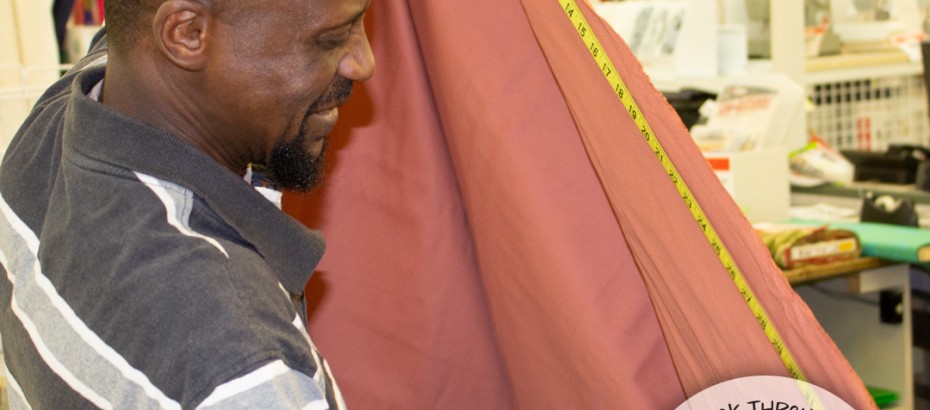A desire to give back motivates Ansumana Gbembo to teach others African tailoring, an art that literally threads people and cultures together. Ansumana is a Muslim man from Sierra Leone in West Africa. In 1995, a civil war forced him to flee to the neighboring country of Guinea. That same year, the United Nations High Commission for Refugees (UNHCR) trained him and others in the camp to sew. By 1998 he had his own business and in 1999 he moved to Gambia, where he sewed for a government minister. In 2009, he became ill and the UNHCR sent him to the U.S. for medical treatment. He has been in Erie, Pennsylvania ever since, and has sewn for more than one hundred people since his arrival.
In June 2017, Ansumana was chosen to be part of the documentary Pennsylvania Folklore: Woven Together, produced by WPSU. The documentary features four folk artists who work with cloth.
Ansumana does not work with a pattern, but instead uses the client’s measurements to create a custom fit. In West African culture, the way you dress greatly influences the way others view, and ultimately, respect you.
Also a designer, Ansumana combines different prints, colors, and styles together. His expertise has brought him many loyal customers, mostly Africans and Arabs now living in the area. He has designed and created wedding gowns, children’s Halloween costumes, and even beekeeping gloves. People often hire him to make clothing for special occasions.
Currently, Ansumana is working with his apprentice Annette Moye, who came to Erie from Cameroon about seven years ago. Ever since her childhood, Annette has wanted to learn to sew African clothes. This is Ansumana’s second apprenticeship funded by the Pennsylvania Council on the Arts.
I had the privilege of meeting Ansumana and Annette to talk about traditional West African clothing and the culture surrounding it.
What do Native Africans want in fashion versus African Americans and Americans in general?
Native Africans seek clothing that is comfortable, wearable, and durable; we like different fabrics, usually cotton. Americans tend to go for simpler styles. They may look at different textures, but they will usually go for more subdued colors than we do. Native Africans like colors and patterns that pop, and for ceremonies and special occasions, we will all wear the same color or print. Another difference is that Americans wear different clothing for different seasons, whereas African clothing is mostly just suitable for warmer weather.
What, if anything, has changed over the years in West African fashion?
Everything is still the same, for the most part. The bold prints change all the time, but they are all bright and big. When you find an African fabric and buy it, that’s all there is of that print. You won’t find it again. We also have a long tradition of tie and dye.
What positives and negatives do you take away from the importance of clothing in West Africa?
I don’t see any negatives. Even though we are here in America, we can still wear African clothes, and we feel good in them. I feel confident wearing them, no matter where I am. There is high respect associated with wearing traditional African clothes, especially at special gatherings. It’s not about you personally, but about respecting your culture and past.
How do you know what to do without a pattern?
Americans work with patterns, but Africans know what to do from scratch because we want to get the best fit possible. American patterns don’t fit everyone properly, and people still often have to get alterations done to ensure the best fit. When I make clothes, the pattern is in my head, and that is the way I was taught. After I take a customer’s measurements, I draw the design outline on the fabric. If they are a regular customer, I may make a paper pattern so that I am prepared to make more clothes for them in the future.
What colors and prints look good on different skin tones, eye colors, etc.?
It depends on what you like, what you feel confident in. A lot of Africans look good in brighter colors like yellows, oranges, and pinks. In African fashion, the particular print and size of the print does not necessarily depend on the body size of the wearer as they may in American fashion. I take my time in making clothes, so that people are satisfied and like what I made them.
Is there a difference in how people carry themselves when wearing something tailor made versus mass produced?
In our culture people feel more proud and important in African prints. They are happier and more outgoing because they feel they look more presentable.
What are some challenges you have faced as a tailor?
It is very challenging to be a tailor in America, because people here are used to ready-made clothing because it is cheaper and more easily accessible. It’s difficult to find people who are willing to pay a higher price, because they may not understand that it is for a higher quality garment. In Africa, tailoring is much more popular.
What are some challenges you have faced teaching others to tailor clothes?
Teaching is not a burden to me, I enjoy it. Everywhere I go I want to share my skills, because I want to help people and make them happy. It can be challenging and stressful if the student is not willing, but a willing student makes for easy teaching. I teach my apprentices to sew for themselves first. Learning to sew neatly takes time, so I first try to teach my apprentice to be patient. I believe that if you put your mind to something, you can do it. It’s not hard. I would be happy to open a place to teach, given the chance.
What jewelry, if any, is typically worn with the clothing of West Africa?
Everyone has their own taste in jewelry. Some like pearls, gold, and silver jewelry, but there are also pieces made of wood, stones, and carved beads. In general, Africans spend more money on clothing than jewelry. A custom-made outfit is a good investment; a thief does not want it, but they may steal your jewelry.
Have you made any clothes for dancers? What are some differences between clothing made for dancers and for everyday wear?
I have, and I would like to make more. Clothing for dancers has to be free flowing, it cannot be tight. The group leaders pick the type of pattern they want, and the rest of the group is dressed in the same pattern. Some of the prints depend on the dance. African dances consist of large, extravagant hand motions, and the large prints reflect that.
I thank Ansumana and Annette, for their fascinating conversation. If you would like to commission Ansumana to make a piece of clothing that fits only you, contact him through the Erie Arts & Culture Community Directory.

Erin Maloney recently obtained her Associate’s degree in Business Administration Marketing & Management from Fortis Institute. She is a poet and a writer who is passionate about art and helping it reach all who can be touched by it. Follow her on Facebook and Instagram.
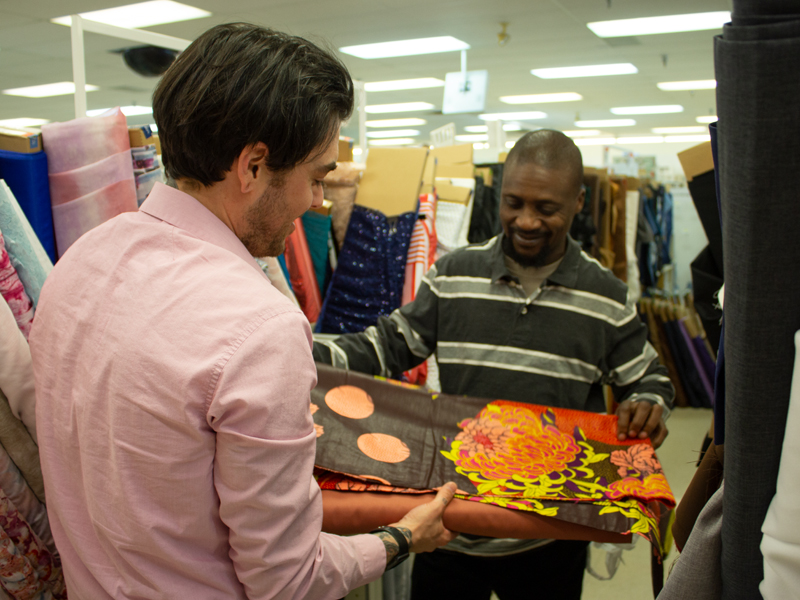
Ansumana helps Erie Arts & Culture's Executive Director, Patrick Fisher, select fabric for his custom suit.
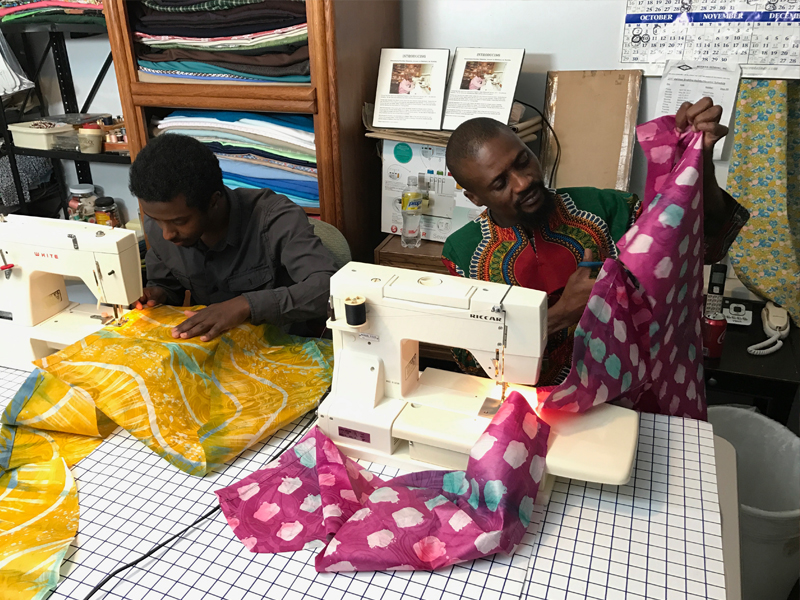
Asumana at work in his studio with Mustafa.
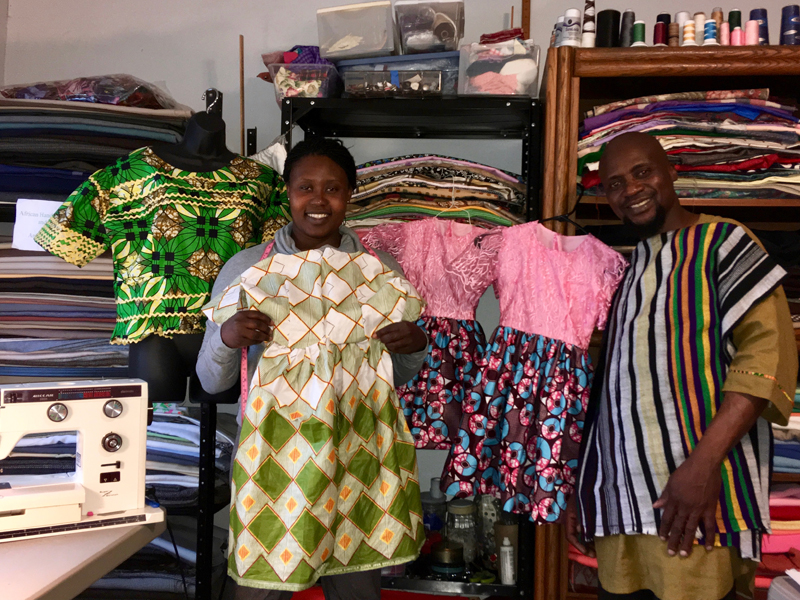
Ansumana with apprentice Annette.
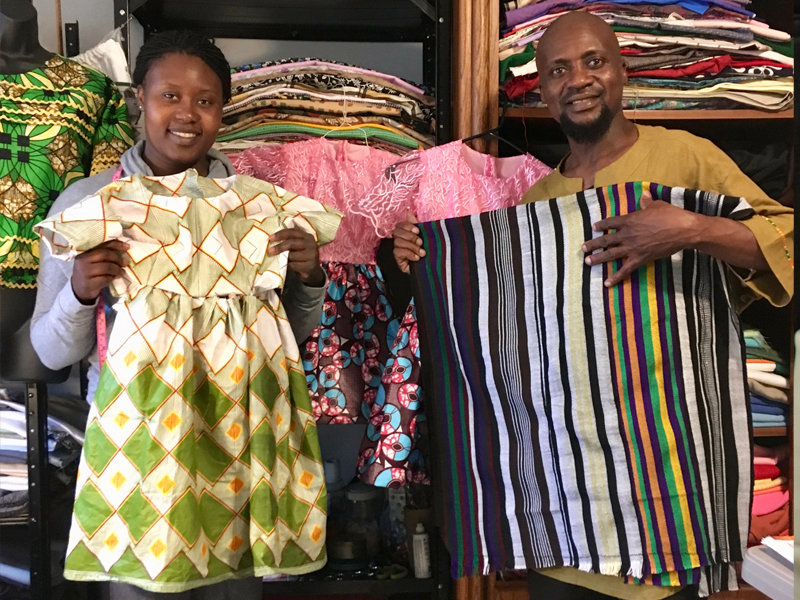
Ansumana with apprentice Annette.
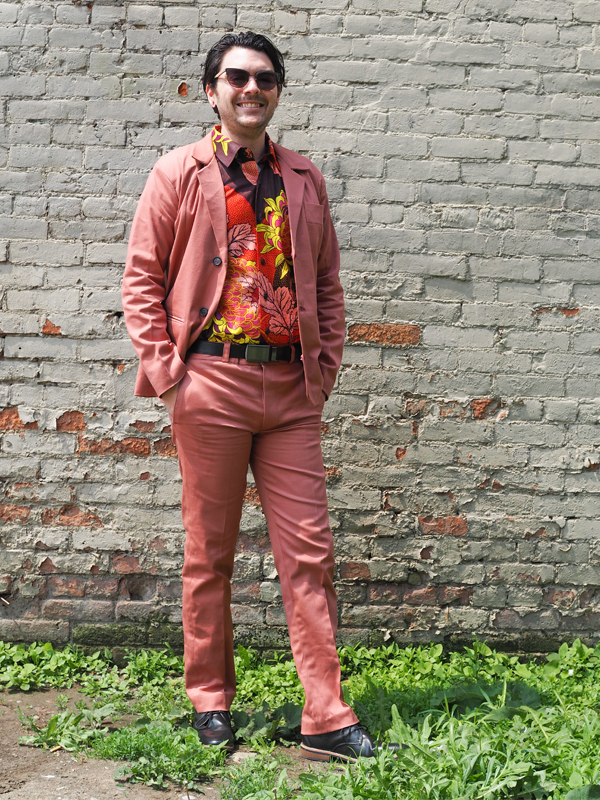
Erie Arts & Culture's Executive Director, Patrick Fisher, wears his custom-tailored Ansumana original suit.

